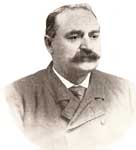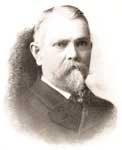THE WORKHOUSE
When the St. Paul workhouse was established at Como in 1883 the tract of land set aside for its use consisted of forty acres. Since then much of this ground has been confiscated for park purposess and the Park Board is yearly growing more urgent in its demand that the institution be removed to another part of the city suburbs. During the first few years of its existence when Como Park was as yet in a crude state the workhouse habitues rendered more or less service in the transformation of the park environs and during the past year 3,274 days of labor were performed but the Park Commissioners do not on the whole consider them desirable neighbors and may soon succeed in having the workhouse banished to a far less beautiful vicinity.
When erected the building was far from being as complete as it is now, new wings and modern improvements having been added from time to time. It is today one of the largest institutions of its kind in this part of the country, containing room for all of 350 prisoners and 158 cells.
The directors are: R. B. Galusha, Charles J. Monfort, William P. Murray, Peter Bohland and Thos. Fitzpatrick. Following are the officers: R. B. Galusha, president; Charles J. Monfort, vice president; Charles M. Koehler, secretary; John Fitzgerald, superintendent; Arthur B. Ancker, physician.
In 1898 954 prisoners were received, of whom 446 were "ten day" men and women. Three were committed for only two days, and seventeen for five days. Sixty-seven were entered for fifteen days, making the total number of "short timers" 533. Very nearly one-half of the prisoners were laborers, no one trade or profession being otherwise liberally represented. The largest number "sent up" were between the ages of twenty-six and thirty, and drunkenness was the immediate cause of 479 arrests. Indeed, the statement is made that only 55 of a year's prisoners claimed to be temperate, whereas 899 admitted themselves addicted to intemperance.
Aside from labor on surrounding roads and routine work the work accomplished by inmates of the workhouse is largely confined to the knitting and broom shops. The annual yield of both these industries, under the able management of Supt. Fitzgerald has been extremely satisfactory inasmuch as it has demonstrated the possibility of more than nominal self support in the near future.
 JOHN F. FITZGERALD
JOHN F. FITZGERALD
It cannot other than be conceded by all that the position of workhouse superintendent is a hard one to fill. The slightest approach to leniency is apt to be construed as partiality and on the other hand too severe a habitual demeanor is at once denounced as indicative of cruelty. In John F. Fitzgerald, who has been superintendent of the St. Paul workhouse for the past fourteen years, a happy medium is presented. Always the quiet, genial man of affairs, Mr. Fitzgerald is today the same conscientious public official as in the days when he was a newcomer and to his strict attention to the demands of duty his success as a correctionist is largely to be attributed.
He is fifty-nine years of age and was brought up in Detroit, Mich. On leaving school he became a ship carpenter and in this capacity sailed on the Great Lakes for many years, three being with Gen. Meade in the U. S. Navy.
Supt. Fitzgerald's experience in taking care of prisoners began in 1869, when he was a subordinate official in the Wayne county, Mich., jail. His next position was in the Detroit House of Correction, where he served seven years, leaving it in 1885 in response to a call from the St. Paul workhouse board. The workhouse at Como was erected in 1883, and F. A. Renz was the first superintendent. He resigned in October, 1885, and Mr. Fitzgerald became his very able successor. Since its opening the workhouse has accommodated 24,286 prisoners, and 21,758 of these have been in charge of the present superintendent.
Supt. Fitzgerald was married on July 15, 1869, to Miss Helen Hackett, an Ontario lady, but at the time a resident of Detroit. Ten children have blessed their union, four of whom have passed away. Those living are: Miss Mary Gertrude, aged 26; John M., aged 24, and at present employed in the auditor's office of the N. P. Railway general office; Grace E, aged 19; Bessie, aged 14; Edward T., aged 12, and little Gerald, aged 10.
The superintendent is a member of the C. M. B. A., a benevolent organization.
 CHARLES M. KOEHLER
CHARLES M. KOEHLER
Go where you may, you will seldom find a more obliging assistant superintendent or a more kindly gentleman than is Charles M. Koehler, who is also the secretary of the St. Paul workhouse. He was born in the principality of Waldeck, Germany, July 27, 1842. His education was begun in a public and finished in a highschool; then he was apprenticed to a mercantile firm, true to the custom of the Fatherland. At the age of eighteen, in 1860, he landed in New York City, and after a few days of sight-seeing went to Detroit, Mich., where he remained five years. Toledo, Ohio, was his next destination, and during the two years spent there he kept a notion store. On disposing of his stock he removed to St. Joseph, Mo., where he obtained employment as a clerk. Ten years passed in this way and then he returned to Detroit, Mich., where he became a guard in the House of Correction. After a six weeks' stay he became overseer and was subsequently promoted to the position of hall master, which he held for two years and a half. At the end of that time he resigned in order to accept the post of warden of the state penitentiary located at Sioux Falls, S. D. He remained in office nearly three years, and then owing to a change of administration and of directors, vacated it and came to St. Paul. Here he was soon stationed as hall master at the workhouse under Supt. Fitzgerald and within six months was promoted to his present position as assistant superintendent and secretary.
In 1891 Mr. Koehler was married to Miss Mary Schultz, of Detroit, Mich., who died in 1894, leaving three children, none of whom long survived their mother.
Mr. Koehler is a member of the Order of Chosen Friends.
MISS THERESA WALSH
The efficient matron of the St. Paul workhouse, was born in the city of Dublin, Ireland, in 1836. When fifteen years of age she accompanied her parents to the United States and to St. Paul, where they are now counted as pioneer residents. Of the whole family, consisting of father and mother and six children, Miss Walsh is the only one alive. She received her appointment as matron in April, 1896.

